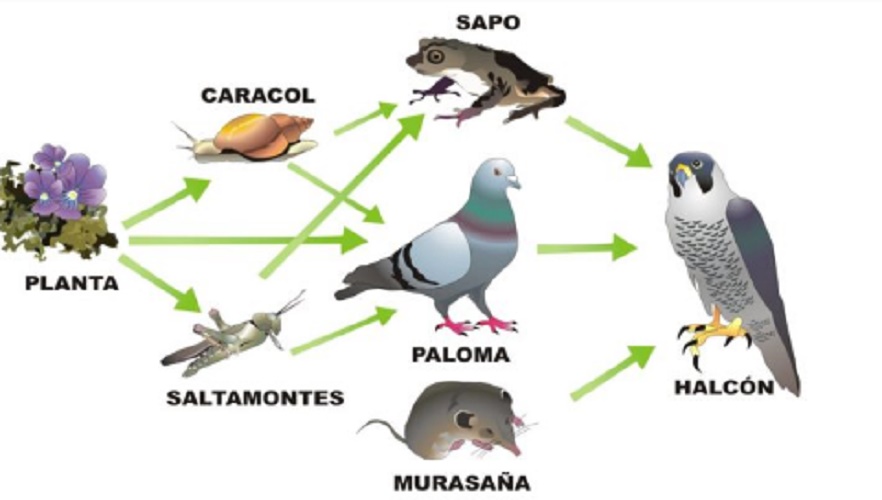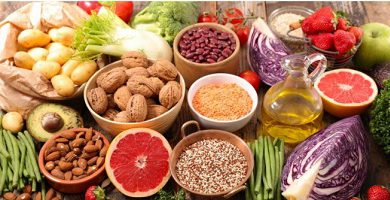What are trophic chains?
We explain what trophic chains are, their characteristics and the types that exist. Also, what is the trophic level and examples.
-
What are trophic chains?
It is known as the food chain, food chain or food chain to the mechanism of transfer of organic matter (nutrients) and energy through the different species of living beings that make up a biological community or ecosystem . Its name comes from the Greek trophos , “feed”, “nurture.”
All biological communities are composed of various life forms related to each other, which share habitat but compete to survive and reproduce, feeding on vegetation, other living things or decomposing matter , in a circuit that is usually understood as a chain, because each link depends on the others to survive.
Thus, we can talk about producers, consumers and decomposers in a food chain:
- Producers . They are those that are nourished using inorganic matter and energy sources such as sunlight. It is the case of photosynthesis .
- Consumers . Instead they are the ones that feed on the organic matter of other living beings, be they producers (herbivores eat plants) or be other consumers (predators eat other animals). Depending on the case, we can talk respectively of primary and secondary consumers (called final if they lack natural predators).
- Decomposers . They are, finally, those who collaborate in the recycling of organic matter, reducing it to its most elementary components and allowing it to be reused by the producers. Fungi, bacteria and insects are the main decomposers.
-
Characteristics of trophic chains

Trophic chains are, first of all, interdependent. That is, that their links or trophic levels depend on each other in a cycle that maintains a certain balance, and that if lost due to human interference or some kind of natural accident, it would cause an imbalance capable of extinguishing species or generating others. ecological damage This occurs especially when invasive species displace the local, when a key predator is extinguished to prevent the disorderly proliferation of smaller species, etc.
On the other hand, in the trophic chains a percentage of energy is lost as it passes from one link to another in the chain. That is, when reaching the final consumer, a significant portion of heat has been lost in the transmission of matter between producer and consumers. In return, chemical energy is transformed from one tissue to another: the wolf does not eat grass, but does eat rabbits that in turn eat grass. Grass energy has reached the transformed wolf, although a portion has been lost along the way.
This can be remedied in some cases, as in the human being, by skipping links in the chain: instead of eating the creature that eats cereals, eating cereals directly.
-
Types of trophic chains
Trophic chains are generally classified according to the habitat in which they take place, so they usually speak of two different types:
- Trophic land chains. Those that take place in the different places of the continental shelf, even under the earth’s surface. For example, the trophic chains of the desert , of the rainforest , etc.
- Trophic aquatic chains. Those that occur in marine or lacustrine environments , and that are composed of creatures adapted to aquatic or underwater life at their various levels, such as the coastal trophic chain or the abyssal areas, etc.
-
Trophic level

Each step of the trophic chain is known as a trophic level . In each one, the different species that share a food activity or a mode of nutrition are located, imaginary or representational, and therefore occupy the same place in the food circuit of the ecosystem.
Trophic levels can be:
- Primary producers or producers. Ways of life endowed with autotrophic nutrition , that is, capable of synthesizing their own food , such as plants.
- Consumers. Those heterotrophic living beings , who must consume the organic matter of others to nourish themselves. They are usually classified into four subpellants, which are:
- Primary Herbivores and other beings that feed on producers directly or their derivatives (seeds, fruits, etc.).
- Secondary Small predators that feed on primary consumers.
- Tertiary Larger predators that feed on secondary consumers.
- Quaternaries or finals. Large predators that feed on tertiary or secondary consumers, and that do not have natural predators.
- Decomposers The nature recycling department , which feeds on carrion, waste, organic matter in the process of decomposition and helps reduce it to its basic materials. They are also called detritophages or saprophages.
-
Trophic pyramid
The trophic or food pyramid is nothing more than a way of representing the trophic chains of an ecosystem in a hierarchical and orderly manner , placing the different trophic levels in rows arranged from the base to the top, usually going from the inorganic world of decomposers, even the end consumers. As the pyramid rises, it advances in the direction of the flow of energy; and when it is descended from the other side, it advances in the direction of decomposition or restitution.
This provision has the virtue that it illustrates very well the numerical proportions between the species that make up each step: the decomposers, producers and primary consumers are much more numerous than the final consumers, since otherwise the cycle could not be repeated.
-
Trophic network

Another way of representing trophic chains is through a food or trophic network, in which it is connected through consumption lines (that is, who eats what or who) to all the species involved in a habitat or in a segment of that habitat , by way of scheme or organization chart .
This type of representation, different from the pyramid, allows you to track the flow of matter or energy between different species , rather than general groupings of species.
-
Trophic chain examples
A couple of examples of the food chain could be the following:
Trophic Garden Chain
- Final consumers. Toads and birds that feed on insects and caterpillars.
- Primary consumers Caterpillars, ants and other insects that feed on plants, or fungi. Also hummingbirds and birds that feed on nectar and fruits.
- Producers Garden plants that make photosynthesis and generate flowers, fruits and seeds.
- Decomposers Fungi, beetles and other insects that feed on fallen leaves, decomposed fruits and the bodies of insects, birds and toads.
Trophic chain of the abyssal zone
- Final consumers. Abyssal fish of greater size, which hunt primary consumers.
- Primary consumers Abyssal fish of small size and jellyfish, which feed on decomposers.
- Producers They do not exist, since there is no sunlight at such depths.
- Decomposers Small crustaceans and mollusks that feed on the rain of organic matter that falls from the upper layers of the sea, as well as the corpses of the abyssal fish.




